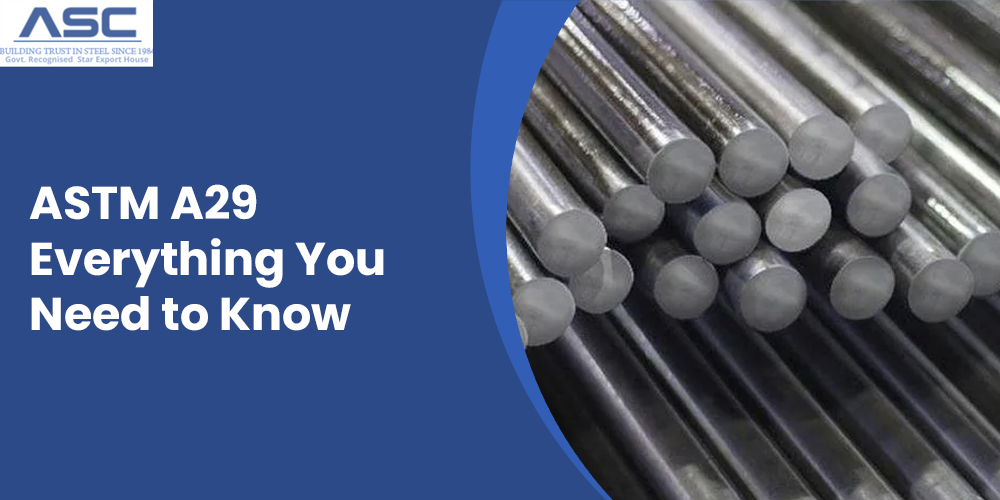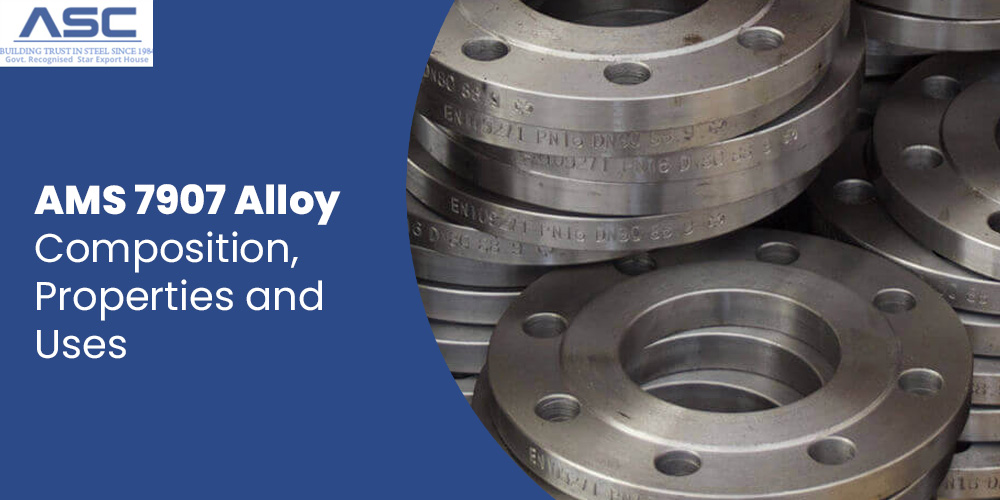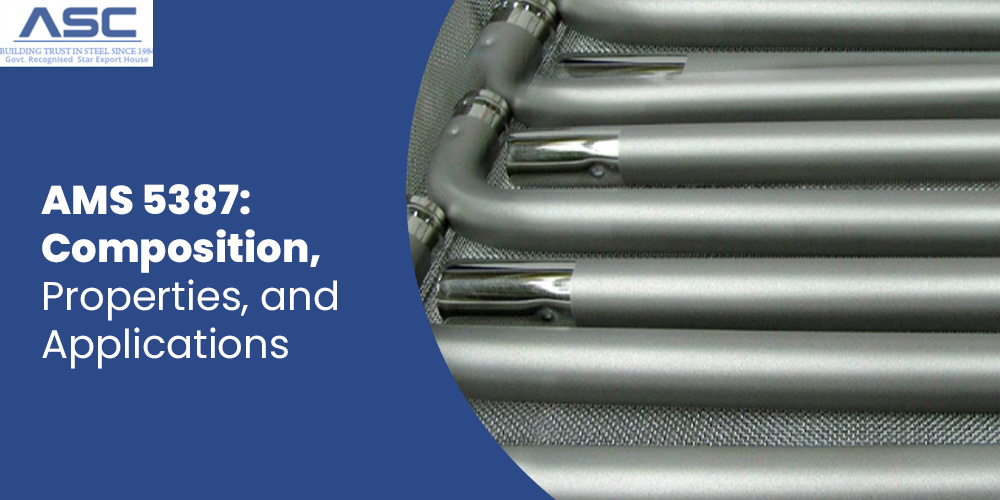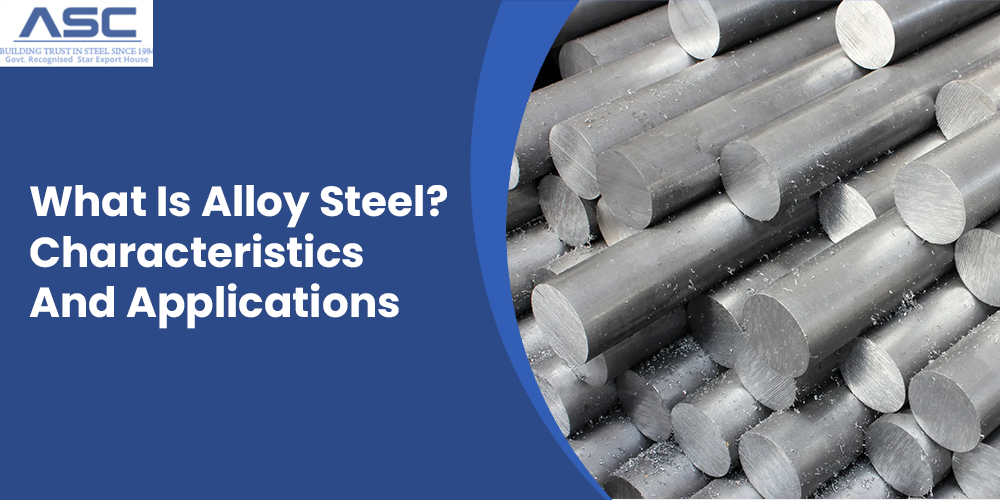ASTM A29 - Everything You Need to Know
by AMC
Posted on May 02, 2024 at 01:00 PM

ASTM A29 is a specification standard published by ASTM International, defining the requirements for hot-wrought steel bars, including carbon, alloy, and stainless steels. This standard plays a crucial role in the industry by providing guidelines for the manufacturing and quality control of steel bars used in various applications.
ASTM A29 covers a wide range of steel grades and compositions, ensuring that manufacturers produce bars with specific mechanical properties, chemical compositions, and processing requirements. This specification is essential for ensuring the quality, consistency, and performance of steel bars in construction, manufacturing, and other industries where high-strength and durable materials are needed.
ASTM A29 Specification
ASTM A29 is a standard specification governing Steel Bars, Carbon and Alloy, Hot-Wrought, General Requirements. It covers various types of steel bars, including hot rolled carbon steel bars, cold finished carbon steel bars, hot rolled alloy steel bars, and cold finished alloy steel bars.
In terms of specific steel grades, ASTM A29 includes carbon steel bar grades such as 1020, 1045, and 1050, among others. Additionally, it encompasses alloy steel bar grades like 4140, 4340, and 5140, among others. These steel grades are commonly used in various industries for their specific mechanical and chemical properties.
| Form | Cold Rolled, Hot Rolled and Forged |
| Specifications and Grades | SAE 4140, AISI 4140, ASTM A29 4140, ASME A29 4140, ASTM A331 4140 (Cold Finish), SCM 440, UNS G41400, AS 1444-1996-4140,DIN 17212 W.Nr 1.7223 Type 41CrMo4, DIN 17200-1654 W.Nr 1.7225 Type 42CrMo4, BS970-1955 EN19A, BS970 Part 3:1991 709M40,ISO 683/II Type 3, isO 683/IV Type 3a, isO 683/IV Type 3b, JIS G 4105 SCM440 |
| ASTM A29 4140 Bar Outer Diameter Range |
5mm to 500mm Dia in 100mm to 6000mm Length |
| ASTM A29 4140 Bar Length |
100mm to 6000mm Length or Customised as per Client |
| Finish | Black, Forged, Bright Polished, Rough Turned, Machined |
| Other Shapes Available | Round, Square, Hex (A/F), Flat, Rectangle, Billet, Ingot, Forging Etc. |
| High Quality |
|
ASTM A29 Chemical Compositions
| Standard | Grade | C | Mn | P | S | Si | Ni | Cr | Mo |
|---|---|---|---|---|---|---|---|---|---|
| SAE 4140 | 4140 | 0.38-0.43 | 0.75-1.00 | 0.035 | 0.040 | 0.15-0.35 | 0.25 | 0.8-1.10 | 0.15-0.25 |
| AISI 4140 | 4140 | 0.38-0.43 | 0.75-1.00 | 0.035 | 0.040 | 0.15-0.35 | 0.25 | 0.8-1.10 | 0.15-0.25 |
| ASTM A29 | 4140 | 0.38-0.43 | 0.75-1.00 | 0.035 | 0.040 | 0.15-0.35 | – | 0.8-1.10 | 0.15-0.25 |
| EN 10250 | 42CrMo4/ 1.7225 |
0.38-0.45 | 0.6-0.9 | 0.035 | 0.035 | 0.4 | – | 0.9-1.2 | 0.15-0.30 |
| JIS G4105 | SCM440 | 0.38-0.43 | 0.60-0.85 | 0.03 | 0.03 | 0.15-0.35 | – | 0.9-1.2 | 0.15-0.30 |
ASTM A29 Mechanical Properties
| Properties | Metric | Imperial |
| Tensile strength | 655 MPa | 95000 psi |
| Yield strength | 415 MPa | 60200 psi |
| Bulk modulus (typical for steel) | 140 GPa | 20300 ksi |
| Shear modulus (typical for steel) | 80 GPa | 11600 ksi |
| Elastic modulus | 190-210 GPa | 27557-30458 ksi |
| Poisson’s ratio | 0.27-0.30 | 0.27-0.30 |
| Elongation at break (in 50 mm) | 25.70% | 25.70% |
| Hardness, Brinell | 197 | 197 |
| Hardness, Knoop (converted from Brinell hardness) | 219 | 219 |
| Hardness, Rockwell B (converted from Brinell hardness) | 92 | 92 |
| Hardness, Rockwell C (converted from Brinell hardness. Value below normal HRC range, for comparison purposes only) | 13 | 13 |
| Hardness, Vickers (converted from Brinell hardness) | 207 | 207 |
| Machinability (based on AISI 1212 as 100 machinability) | 65 | 65 |
ASTM A29 Equivalent Material
| ASTM A29 Grade | Equivalent Materials |
|---|---|
| 1020 | ASTM A108, AISI/SAE 1020, EN/DIN C22, JIS S20C |
| 1045 | ASTM A108, AISI/SAE 1045, EN/DIN C45, JIS S45C |
| 1050 | ASTM A108, AISI/SAE 1050, EN/DIN C50, JIS S50C |
| 4140 | ASTM A108, AISI/SAE 4140, EN/DIN 1.7225, JIS SCM440 |
| 4340 | ASTM A108, AISI/SAE 4340, EN/DIN 1.6565, JIS SNCM439 |
| 5140 | ASTM A108, AISI/SAE 5140, EN/DIN 1.7035, JIS SCr440 |
ASTM A29 Heat Treatment
ASTM A29 does not provide specific heat treatment guidelines for individual steel grades. Instead, it outlines general principles and requirements for hot-wrought steel bars, including carbon and alloy steels. The heat treatment of steel bars under ASTM A29 typically follows industry standards and practices based on the specific steel grade and intended application.
Here are the general steps involved in heat treating steel bars according to ASTM A29:
- Heating: The steel bars are heated to a specific temperature range depending on the steel grade and desired properties. This temperature range is typically above the critical transformation temperature for the specific steel alloy.
- Soaking: Once the steel bars reach the desired temperature, they are held at that temperature for a specified period to ensure uniform heating throughout the material. This process is called soaking or annealing.
- Quenching: After soaking, the steel bars are rapidly cooled, known as quenching, to achieve the desired hardness and microstructure. The quenching medium (such as water, oil, or polymer solutions) and cooling rate depend on the steel grade and required mechanical properties.
- Tempering: Some steel grades may undergo tempering after quenching to relieve internal stresses and improve toughness. Tempering involves reheating the hardened steel bars to a lower temperature and holding them for a specific time before cooling.
- Testing and Quality Control: After heat treatment, the steel bars undergo various tests to ensure they meet the specified mechanical properties, such as hardness, strength, and ductility. Quality control measures are taken to verify the effectiveness of the heat treatment process.
Hardening of ASTM A29
Heating: Preheat the steel to a temperature range typically between 815°C to 900°C (1500°F to 1650°F), depending on the specific steel grade and desired hardness. Hold the steel at this temperature for sufficient time to ensure uniform heating throughout the material.
Soaking: Once the steel reaches the desired temperature, hold it at that temperature for a specific period (often determined by the steel grade and section thickness) to allow for thorough soaking and transformation of the microstructure.
Quenching: After soaking, quickly transfer the steel to a quenching medium such as oil, water, or polymer solutions. The choice of quenching medium depends on factors like the steel grade, section thickness, and desired hardness profile. Quenching rapidly cools the steel, causing martensitic transformation and achieving high hardness.
Tempering (Optional): Some steel grades may undergo tempering after quenching to reduce internal stresses, improve toughness, and achieve the desired balance of hardness and strength. Tempering involves reheating the hardened steel to a lower temperature (typically between 150°C to 600°C or 300°F to 1100°F) and holding it for a specific time before cooling.
Testing and Quality Control: After hardening and optionally tempering, the steel undergoes testing to verify its hardness, mechanical properties, and microstructure. Quality control measures are taken to ensure the effectiveness of the hardening process and compliance with specifications.
ASTM A29 Application Industries
ASTM A29 specification covers a wide range of steel bars, including carbon and alloy steel bars, that are hot-wrought and used in various industries for different applications. Here are some of the key industries and applications where ASTM A29 steel bars find usage:
- Automotive Industry: ASTM A29 steel bars are used in automotive components such as crankshafts, axles, gears, and transmission parts due to their strength, durability, and wear resistance.
- Machinery and Equipment: These steel bars are utilized in machinery and equipment manufacturing for parts like shafts, bolts, fasteners, and machine components requiring high strength, toughness, and machinability.
- Construction and Infrastructure: In construction, ASTM A29 steel bars are employed for structural components, reinforcement bars, and fasteners in buildings, bridges, roads, and infrastructure projects due to their strength, weldability, and corrosion resistance.
- Oil and Gas Industry: Steel bars meeting ASTM A29 specifications are used in the oil and gas sector for drill collars, shafts, valves, and fittings where high strength, toughness, and resistance to harsh environments are essential.
- Aerospace and Defense: Aerospace applications utilize ASTM A29 steel bars for aircraft components, landing gear, engine parts, and structural elements requiring lightweight yet strong materials with good fatigue resistance.
- Power Generation: Steel bars from ASTM A29 are employed in power generation equipment such as turbines, generators, and turbines for their high-temperature strength, corrosion resistance, and reliability.
- Manufacturing and Fabrication: Various manufacturing and fabrication industries use ASTM A29 steel bars for general machine parts, tools, dies, and components requiring high mechanical properties, machinability, and surface hardness.
- Railways: In railway applications, these steel bars are utilized for rail track components, couplings, and fittings due to their strength, toughness, and wear resistance under heavy loads.
- Mining and Heavy Equipment: ASTM A29 steel bars find use in mining equipment, heavy machinery, and material handling systems for parts subjected to high stress, impact, and abrasion.
- Renewable Energy: Components in renewable energy systems like wind turbines, solar panel frames, and hydroelectric equipment utilize ASTM A29 steel bars for their durability, strength, and resistance to environmental factors.
Conclusion
ASTM A29 stands as a cornerstone in the steel industry, providing a standardized specification for hot-wrought carbon and alloy steel bars. Its significance reverberates across a multitude of industries, from automotive and construction to aerospace and manufacturing. The versatility of ASTM A29 steel bars lies in their ability to meet stringent requirements for strength, durability, machinability, and corrosion resistance. The heat treatment capabilities of ASTM A29 further enhance its utility, allowing for tailored properties to suit specific applications. From hardening to tempering, these processes imbue the steel bars with the desired mechanical characteristics, making them indispensable in demanding environments.

AMS 7907 Alloy - Composition, Properties and Uses
If you work in the aerospace or defense industry, you've likely come across AMS 7907. This material finds common usage in the manufacture of high-performance engine components, bearings, and turbine blades.

